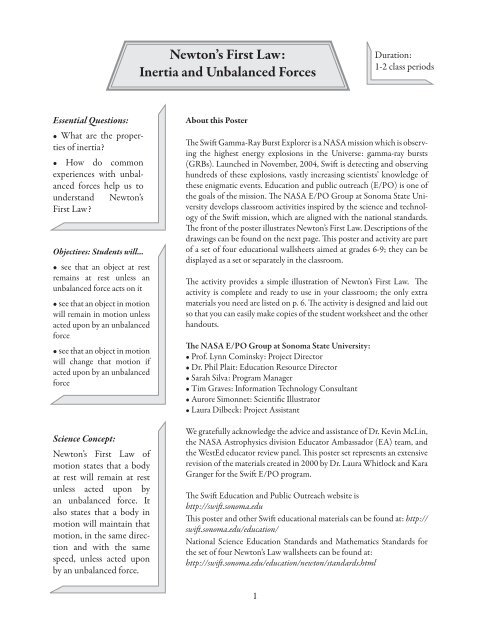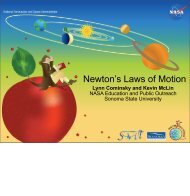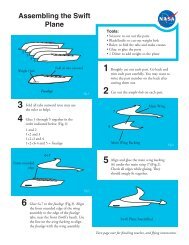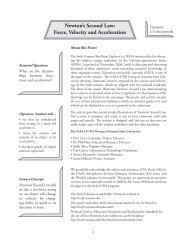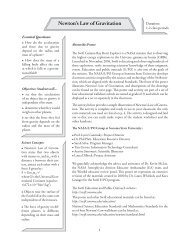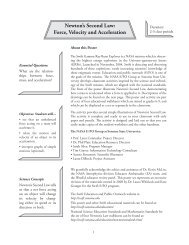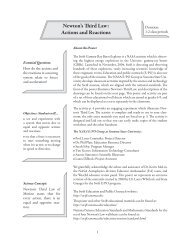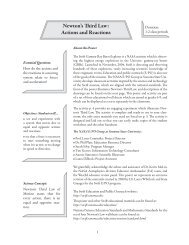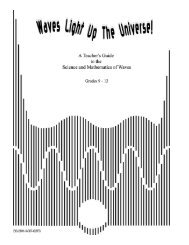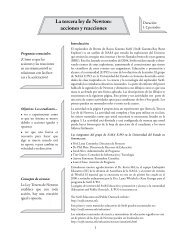Newton's First Law: Inertia and Unbalanced Forces - Swift - Sonoma ...
Newton's First Law: Inertia and Unbalanced Forces - Swift - Sonoma ...
Newton's First Law: Inertia and Unbalanced Forces - Swift - Sonoma ...
- No tags were found...
Create successful ePaper yourself
Turn your PDF publications into a flip-book with our unique Google optimized e-Paper software.
Newton’s <strong>First</strong> <strong>Law</strong>:<strong>Inertia</strong> <strong>and</strong> <strong>Unbalanced</strong> <strong>Forces</strong>Duration:1-2 class periodsEssential Questions:• What are the propertiesof inertia?• How do commonexperiences with unbalancedforces help us tounderst<strong>and</strong> Newton’s<strong>First</strong> <strong>Law</strong>?Objectives: Students will…• see that an object at restremains at rest unless anunbalanced force acts on it• see that an object in motionwill remain in motion unlessacted upon by an unbalancedforce• see that an object in motionwill change that motion ifacted upon by an unbalancedforceScience Concept:Newton’s <strong>First</strong> <strong>Law</strong> ofmotion states that a bodyat rest will remain at restunless acted upon byan unbalanced force. Italso states that a body inmotion will maintain thatmotion, in the same direction<strong>and</strong> with the samespeed, unless acted uponby an unbalanced force.About this PosterThe <strong>Swift</strong> Gamma-Ray Burst Explorer is a NASA mission which is observingthe highest energy explosions in the Universe: gamma-ray bursts(GRBs). Launched in November, 2004, <strong>Swift</strong> is detecting <strong>and</strong> observinghundreds of these explosions, vastly increasing scientists’ knowledge ofthese enigmatic events. Education <strong>and</strong> public outreach (E/PO) is one ofthe goals of the mission. The NASA E/PO Group at <strong>Sonoma</strong> State Universitydevelops classroom activities inspired by the science <strong>and</strong> technologyof the <strong>Swift</strong> mission, which are aligned with the national st<strong>and</strong>ards.The front of the poster illustrates Newton’s <strong>First</strong> <strong>Law</strong>. Descriptions of thedrawings can be found on the next page. This poster <strong>and</strong> activity are partof a set of four educational wallsheets aimed at grades 6-9; they can bedisplayed as a set or separately in the classroom.The activity provides a simple illustration of Newton’s <strong>First</strong> <strong>Law</strong>. Theactivity is complete <strong>and</strong> ready to use in your classroom; the only extramaterials you need are listed on p. 6. The activity is designed <strong>and</strong> laid outso that you can easily make copies of the student worksheet <strong>and</strong> the otherh<strong>and</strong>outs.The NASA E/PO Group at <strong>Sonoma</strong> State University:• Prof. Lynn Cominsky: Project Director• Dr. Phil Plait: Education Resource Director• Sarah Silva: Program Manager• Tim Graves: Information Technology Consultant• Aurore Simonnet: Scientific Illustrator• Laura Dilbeck: Project AssistantWe gratefully acknowledge the advice <strong>and</strong> assistance of Dr. Kevin McLin,the NASA Astrophysics division Educator Ambassador (EA) team, <strong>and</strong>the WestEd educator review panel. This poster set represents an extensiverevision of the materials created in 2000 by Dr. Laura Whitlock <strong>and</strong> KaraGranger for the <strong>Swift</strong> E/PO program.The <strong>Swift</strong> Education <strong>and</strong> Public Outreach website ishttp://swift.sonoma.eduThis poster <strong>and</strong> other <strong>Swift</strong> educational materials can be found at: http://swift.sonoma.edu/education/National Science Education St<strong>and</strong>ards <strong>and</strong> Mathematics St<strong>and</strong>ards forthe set of four Newton’s <strong>Law</strong> wallsheets can be found at:http://swift.sonoma.edu/education/newton/st<strong>and</strong>ards.html1
as it was for it to be at rest. It was only in our imperfect, friction-filled world that we needed to continue topush an object to get it to move.Isaac Newton built upon Galileo’s ideas. He agreed that an object would continue to move even if no forceacted on it. He also understood that more than one force can act on an object at the same time. The combinationof these forces is important. For example, imagine two teams playing tug-of-war; each pulls on a ropein opposite directions. If one team is stronger, then their force is greater <strong>and</strong> they pull the other team towardthem. In this situation, when two forces are not equal, we say they are unbalanced. However, if the two teamshave equal strength, the force they apply to the rope is equal – balanced– <strong>and</strong> neither team moves.In his work known as the “Principia,” published in 1687, Newton wrote about his ideas on forces <strong>and</strong> motion(<strong>and</strong> readily acknowledged his debt to Galileo). He created three laws, today called Newton’s <strong>Law</strong>s of Motion.His <strong>First</strong> <strong>Law</strong> of Motion stated: A body continues at rest or in motion in a straight line with a constant speeduntil acted on by an unbalanced force. The tendency of a body to resist change is called inertia. Newton’s <strong>First</strong><strong>Law</strong> is often referred to as the <strong>Law</strong> of <strong>Inertia</strong>.Newton’s <strong>Law</strong>s apply to macroscopic systems – things you can feel <strong>and</strong> see. There are environments for whichNewton’s <strong>Law</strong>s (or Classical Mechanics) only provide an approximate answer, <strong>and</strong> more general physical lawsmust be used. For example, black holes <strong>and</strong> objects moving at nearly the speed of light are more accuratelyexplained by General Relativity, while subatomic particles are explained by Quantum Mechanics.Pre-Activity Reading:Newton’s <strong>First</strong> <strong>Law</strong> <strong>and</strong> the <strong>Swift</strong> SatelliteOn November 20, 2004, the <strong>Swift</strong> satellite was sealed in the nosecone of a Delta 2 rocket, ready for launchfrom Cape Canaveral, Florida. Immediately prior to launch, <strong>Swift</strong> was “an object at rest” <strong>and</strong> so was the rocket.There was no unbalanced force on <strong>Swift</strong> or the rocket, so both of them remained at rest. When the solid rocketboosters ignited at 12:16:00 p.m. EST, an unbalanced force was applied to the rocket. For the first few secondsof the launch, the rocket exhaust went straight down, pushing the rocket straight up, in a line. You can see the<strong>Swift</strong> launch in a video at:http://www.nasa.gov/mission_pages/swift/multimedia/index.htmlPre-Activity Discussion:Ask the following questions to introduce Newton’s <strong>First</strong> <strong>Law</strong> to your class:• When were the <strong>Swift</strong> satellite <strong>and</strong> rocket at rest?• When were the <strong>Swift</strong> satellite <strong>and</strong> rocket in motion in a straight line?• What happens when you are riding in a car with a seat belt on, <strong>and</strong> the car starts or stops suddenly?• What would happen if you were not wearing your seat belt?• What is providing the unbalanced force for the <strong>Swift</strong> launch? For the car?• Can you think of some more examples when your body is in motion <strong>and</strong> it is acted on by an unbalancedforce?3
Answers to Non-<strong>Swift</strong> Pre-Activity Discussion Questions:When you are riding in a car with a seat belt on, <strong>and</strong> the car starts suddenly, you feel the back of the seat pushagainst your back as the car begins to move. This is because your inertia tries to hold you – in the originalposition – but the car is starting to move forward. Since you are held in the seat by the seatbelt, when the carstops suddenly, you move forward, <strong>and</strong> feel the seatbelt push against you, holding you in place. If you were notwearing your seat belt, you would continue your forward motion as the car stops, <strong>and</strong> would smash into thewindshield or dashboard of the car. The car is providing the unbalanced force as it accelerates or decelerates.Other examples include: flying in an airplane as it takes off <strong>and</strong> l<strong>and</strong>s (wearing a seatbelt!), riding in a train orbus (where seatbelts are not as common because accelerations <strong>and</strong> decelerations are usually more gradual), orskateboarding (where if the wheels of the board hit a rock, the board can stop, but you keep going).Procedure for In-class activity: <strong>Inertia</strong> <strong>and</strong> <strong>Unbalanced</strong> <strong>Forces</strong>:The basic procedure for most students is described in the student’s h<strong>and</strong>out.In addition, you may wish to write vocabulary on the board (such as inertia, force, acceleration) <strong>and</strong> promptthe students to explain their observations using the vocabulary.For advanced students, you can add the post <strong>and</strong>/or extension activities to add additional opportunities forreflection.The answers below pertain to the student questions.Answers to In-Class Activity Questions:Question 2: When the car <strong>and</strong> figure are sitting on the desk, there is no unbalanced force acting on them, sothey do not move (an object at rest tends to stay at rest). There are forces acting on them: gravity, for one, ispulling them down toward the center of the Earth. But this force is exactly balanced by the surface of the desk,which is pushing them up. This may be a difficult concept for the students to underst<strong>and</strong>. One way to explainit to them is to ask them what would happen if the desk were to be replaced by a very thin sheet of rubber. Thecar would sink a bit, stretching the rubber sheet, tightening it. The force of gravity is stronger than the forceof the rubber sheet trying to contract <strong>and</strong> support the car. When the sheet stretches enough, the tension in itis strong enough to balance gravity, <strong>and</strong> once again motion stops.Question 4: When you put the car on the ramp, gravity will act on it, pulling it down. The car <strong>and</strong> figure areboth pulled by gravity, <strong>and</strong> both move down the ramp together. When the car reaches the floor, once againgravity is balanced by the floor itself, so the forces on the car are balanced, yet it keeps moving (an object inmotion tends to stay in motion). It may eventually hit a chair or a wall, but until it does it should move relativelysmoothly. It will slow down due to friction as well.Question 6: When the car hits the book, the car stops <strong>and</strong> the book does not move (or moves very little). Thebook has more inertia than the car, <strong>and</strong> is also being held in place by friction. The book does not move, whilethe motion of the car is stopped. Another way to think of it is that the book applied a large force to the car,stopping it (an object in motion tends to remain in motion unless acted on by an unbalanced force). However,this force is applied only to the car, <strong>and</strong> not to the figure. Since an object in motion tends to remain inmotion, the figure will fly off the car. Ouch!4
Question 8: This is why we use seat belts,to counteract that tendency to remainin motion. The seat belt applies a forceto a person that keeps them from flyingout of the car. Even better are air bags,which apply a smaller force to a personover a larger area than a seat belt, so theperson is protected in more areas thanjust the lap <strong>and</strong> shoulder.Do not try this at home!Question 9: When the car hits the wadded piece of paper, the paper is knocked away. This is because the car hasmore inertia than the paper, so the paper is easier to move. The force from the car is not enough to move the book,but it is easily enough to move the paper.Post-Activity Demonstration (Advanced students):A chunk of dry ice allowed to sit on the floor for a few minutes will get a flat surface underneath it as the warmfloor turns the dry ice into a gas. The chunk of dry ice will float on that gas, like an air hockey puck (see ExtensionActivity below). A small flick of the finger will cause the chunk to move in a straight line across the floor at aconstant speed. It is actually quite odd to see this, since we are used to friction (a force!) slowing things down.Warning: Dry ice is extremely cold, <strong>and</strong> can cause severe frostbite. If you perform this demo,follow safety procedures for dry ice (for example, http://www.abc.net.au/science/surfingscientist/pdf/lesson_plan08.pdf <strong>and</strong> http://www.school-for-champions.com/science/dry_ice.htm). Wear thickgloves, <strong>and</strong> don’t allow the students to touch the dry ice directly.Post-Activity (optional):Watch the demonstration of a chunk of “dry ice” moving across the floor. How does this illustrate Newton’s<strong>First</strong> <strong>Law</strong>?Extension Activity (Advanced students):When <strong>Swift</strong> launched on board the rocket, it was bolted to the rocket. A little over an hour after launch, at1:36 pm, the bolts holding it in place were cut. Then, 30 seconds later, the rocket fired “reverse thrusters” whichbacked it away from the <strong>Swift</strong> spacecraft. You can see the video of this, from a camera on-board the rocket, at:http://www.nasa.gov/mission_pages/swift/timeline/index.htmlHow does the motion of the <strong>Swift</strong> spacecraft in this video illustrate Newton’s <strong>First</strong> <strong>Law</strong>?For a more “down-to-Earth” example, go play air hockey. An air-hockey table is a good example of an almostfrictionless surface. Ask the students the following: Why does the puck stop when the air stops? What makesit frictionless? Would the puck go on forever if it could? (If the walls of the table didn’t stop it.) How is this anexample of Newton’s <strong>First</strong> <strong>Law</strong>?5
Post <strong>and</strong> Extension Activity Answers:When <strong>Swift</strong> was bolted inside the rocket’s nosecone, it continued to remain in motion in the same direction <strong>and</strong>with the same speed as the rocket. When the bolts were retracted, no force was applied to either the rocket or<strong>Swift</strong>, so both continued to travel together in the same direction <strong>and</strong> at the same speed. When the rocket firedits reverse thrusters, an unbalanced force was applied to the rocket, but not to <strong>Swift</strong>. The rocket then movedaway from <strong>Swift</strong>, increasing their separation, letting <strong>Swift</strong> orbit freely around the Earth.The puck stops when the air stops because the friction on the puck becomes very large. The air cushion providesan almost frictionless surface, on which the puck will continue to move until it hits an obstruction like the edgeof the table. Of course, the air cushion is not perfectly frictionless, <strong>and</strong> if the table were very large, eventually thepuck would stop due to the small amount of friction that is present. This illustrates Newton’s <strong>First</strong> <strong>Law</strong> in showingthat an object in motion will continue that motion in a straight line when there are no unbalanced forcesacting on it. A chunk of dry ice floats on a cushion of gas in a similar manner.Assessment:Points43Sudden ImpactA) Student is able to correctly predict the motion of objects moving with <strong>and</strong>B) without friction, along a straight line. C) Student knows that inertia is thetendency of an object to resist a change in its motion. D) Student can correctlyidentify unbalanced forces <strong>and</strong> can predict the results of such forces.A) Student is able to predict the motion of objects moving with friction alonga straight line. B) Student can identify friction as an unbalanced force. C)Student knows that inertia is the tendency of an object to resist a change in itsmotion.2 Student achieves any two of the three objectives above.1 Student achieves one of the three objectives above.0 Student achieves none of the three objectives above.Materials:• A toy car, such as a matchbox car or anythinglike it that can roll• A toy figure of a person small enoughto sit on the car (a clay figure will work aswell)• A piece of cardboard or wood about ameter long to use as a ramp• Something on which to prop the ramp,such as a stack of books or the seat of achair• An object big <strong>and</strong> heavy enough to stopthe car from rolling, such as a book or ameter stick taped to the floorStack of booksRamp6The “littleguy”Book to stopthe carToy car
Student H<strong>and</strong>out:<strong>Inertia</strong> <strong>and</strong> <strong>Unbalanced</strong> <strong>Forces</strong>This activity will help you learn about Newton’s <strong>First</strong> <strong>Law</strong> of Motion. In this experiment youwill discover the properties of inertia <strong>and</strong> motion, <strong>and</strong> see how they have very important real-lifeapplications.Procedure: Sudden ImpactUse a separate sheet of paper to take notes <strong>and</strong> follow the instructions:1. Place the car on a flat, steady surface likea desk top. Place the figure of a person onthe car. Important: don’t press it down so itsticks; just let it rest there.2. Observe the car. Are there any forcesacting on it? What about the figure? DoesNewton’s <strong>First</strong> <strong>Law</strong> apply here? Write downyour thoughts.3. Place one end of the board on a stack ofbooks or the edge of a seat to create a ramp.Make sure there is plenty of room at thebase of the ramp for the car to roll.4. Using Newton’s <strong>First</strong> <strong>Law</strong>, predict whatwill happen when the car rolls down theramp <strong>and</strong> record this on your worksheet.5. Place the car <strong>and</strong> figure at the top of theramp. Let go, allowing the car <strong>and</strong> figureto roll down. Observe what happens, <strong>and</strong>record it.6. Now place a heavy object such as a booknear the bottom of the ramp, so that thecar will hit it. Again, using Newton’s <strong>First</strong><strong>Law</strong>, predict what will happen to the car,the figure, <strong>and</strong> the book when the car hitsthe book.7. Repeat the experiment above, againmaking sure the figure is placed on the car,not stuck on it. Record your observations.What happened to the book, the car, <strong>and</strong> thefigure? Were your predictions accurate?8. How is this experiment applicable in reallife? If you were a car designer, what kind offeature would you add to a car after performingthis experiment?9. Now replace the heavy book with a waddedup piece of paper, again making sure it is inthe path of the car. Using Newton’s <strong>First</strong><strong>Law</strong>, predict what will happen when the car,the figure, <strong>and</strong> the paper wad impact. Recordyour prediction.10. Repeat the experiment, recording yourobservations of the car, the figure, <strong>and</strong> thepaper wad. Was this situation different thanbefore? If so, what specifically was different,<strong>and</strong> why did this change the outcome of theexperiment? If nothing changed, why not?7
Example drawings that could represent the student’spredictions <strong>and</strong>/or observations for question 7.a. The small figure is not attached to the car as it rolls down the ramp.b. The small figure <strong>and</strong> the car accelerate down the ramp.c. At the bottom, the car is stopped by the stack of books, but the small figure continues to move.Ouch!8
References for all Four Posters:Copies of these materials, along with additional information on Newton’s <strong>Law</strong>s of Motion <strong>and</strong> <strong>Law</strong> ofGravitation, are available on the <strong>Swift</strong> Mission Education <strong>and</strong> Public Outreach Web site:http://swift.sonoma.edu/• NASA Web sites:NASA’s official Web site - http://www.nasa.gov<strong>Swift</strong> Satellite - http://swift.gsfc.nasa.gov• NASA Education Resources:The Space Place - http://spaceplace.nasa.govImagine the Universe! - http://imagine.gsfc.nasa.gov• NASA’s Central Operation of Resources for Educators (CORE):http://education.nasa.gov/edprograms/core/home/index.htmlCheck out these videos:“Liftoff to Learning: Newton in Space” (1992), $15.00“Flight Testing Newton’s <strong>Law</strong>s” (1999), $24.00• NASA’s Space Science Education Resource Directory:http://teachspacescience.org• Newton’s <strong>Law</strong>s of Motion:http://www-istp.gsfc.nasa.gov/stargaze/Snewton.htmhttp://www.grc.nasa.gov/WWW/K-12/airplane/newton.html• Newton’s <strong>Law</strong> of Gravitation:http://csep10.phys.utk.edu/astr161/lect/history/newtongrav.html• Newton in the Classroom:http://www.physicsclassroom.com/Class/newtlaws/newtltoc.htmlhttp://www.glenbrook.k12.il.us/gbssci/phys/Class/newtlaws/u2l1a.html• The Nine Planets:http://seds.lpl.arizona.edu/nineplanets/nineplanets/nineplanets.htmlhttp://seds.lpl.arizona.edu/nineplanets/nineplanets/data1.htmlhttp://swift.sonoma.edu


